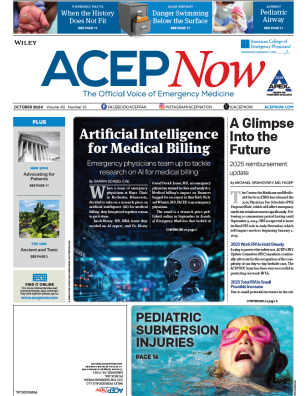
Six accepted ED practices that are potentially harmful, costly, inefficient, or just don’t work
I’m always a bit tickled (yes, I said tickled) by the lofty discussions about evidenced-based medicine when much of what is done in medicine and many things we do in emergency medicine have little supporting evidence. It seems that our focus is the evolution of current management and diagnostic strategies and developing research strategies to prove or disprove our hypotheses. Although asking new questions and adding new literature to the world’s research database is critical to the evolution of medical practice, what is easier and more critical is questioning what we already do based on evidence that already exists. In other words, we might be asking the right question at the wrong time—or the wrong question altogether.
Explore This Issue
ACEP Now: Vol 33 – No 01 – January 2014As much as we claim to be scientists and practice with evidence as our guide, much of the care that is delivered in emergency departments comes from folklore. We have all—present company included—practiced in ways we absolutely believed to be best practice only to find out later that we may have been wrong. Hey, you don’t know what you don’t know.
There is great value in learning from great educators. However, we can get lost in the “greatness” of our mentors. Many edicts in medical education were taught to those we trust today by those whom they trusted yesterday. Once a learned, respected colleague states a “fact” with confidence, it often becomes unchallenged evidence and is passed down from one generation to the next. Evidence of my lack of social life, I enjoy using the “hot-tub time machine,” revisiting the land of lost medical questions to see if today’s evidence still supports these previously “answered” questions. It is amazing what you can find when you look.
Ultimately, there is still great latitude to practice the art of medicine. However, my goal is to challenge many commonly accepted practices that are potentially harmful, are expensive, create operational inefficiency, or simply just don’t work.
Prasad et al. published a very interesting article in JAMA in January 2012.1 They reviewed 35 clinical trials published in 2009 that tested established practices. They found that 46 percent of them contradicted current practice. This is evidence that medical reversals are common. Below are six myths worth challenging.
Many edicts in medical education were taught to those we trust today by those whom they trusted yesterday. Once a learned, respected colleague states a “fact” with confidence, it often becomes unchallenged evidence.
1. Tramadol or Tramacrap?
I’m no marketing expert, but despite that the name “Tramacrap” or “Ultracrap” would describe this drug perfectly, I doubt we’ll see a name change any time soon. Medve et al. published an article 12 years ago that demonstrates this nicely.2 They assessed the efficacy of tramadol for the treatment of dental pain, and in the emergency department, this indication is perfectly matched with the drug. Many physicians look for that “tweener” drug that the patient is less familiar with, is not an opioid, and still provides reasonable analgesia. This study identified the following order of efficacy (at eight hours): ibuprofen 400mg, tramadol/APAP 75/650, APAP 650, tramadol 75, and placebo. Further, the onset of action was 17 minutes for tramadol/APAP, 18 minutes for APAP, 34 minutes for ibuprofen, 51 minutes for tramadol, and 66 minutes for placebo.2 Tramadol does not taste great, nor is it less filling.
Pages: 1 2 3 | Single Page





3 Responses to “Myths in Emergency Medicine”
March 20, 2014
tramadol efficacy? | DAILYEM[…] article by Dr. Klauer in January’s ACEP Now. covers a few topics, but here’s one […]
December 19, 2014
Myths in Emergency Medicine | VGH Emergency Department[…] https://www.acepnow.com/article/myths-emergency-medicine/ […]
January 10, 2019
MegWhere are your links to sources?